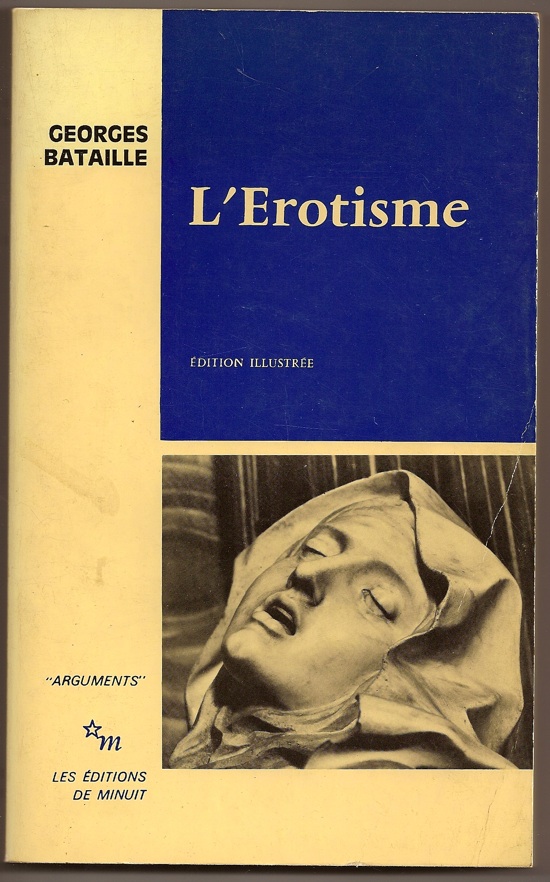Georges Bataille: Erotism: Death and Sensuality (1957–) [FR, ES, EN, IT, PT]
Filed under book | Tags: · death, ecstasy, eroticism, language, psychology, religion, sex, sexuality

Taboo and sacrifice, transgression and language, death and sensuality—Georges Bataille pursues these themes with an original, often startling perspective. He challenges any single discourse on the erotic. The scope of his inquiry ranges from Emily Bronte to Sade, from St. Therese to Claude Levi-Strauss and Dr. Kinsey; and the subjects he covers include prostitution, mythical ecstasy, cruelty, and organized war. Investigating desire prior to and extending beyond the realm of sexuality, he argues that eroticism is “a psychological quest not alien to death.”
First published in French as L’Érotisme, Éditions de Minuit, 1957.
This edition published within Oeuvres complètes. Tome 10 (pp 1-270), together with Le procès de Gilles de Rais and Les larmes d’Éros.
Publisher Gallimard, 1987
734 pages
English edition
Translated by Mary Dalwood
The first edition in English was published as Death and Sensuality: a Study of Eroticism and the Taboo, Walker and Company, NY, 1962.
Publisher City Lights Books, San Francisco, 1986
ISBN 0872861902, 9780872861909
280 pages
Review (Mark Price, Philosophy Now)
L’Érotisme (French, 1957/1987). Alt link.
El erotismo (Spanish, transcript, trans. María Luisa Bastos, 1960)
Erotism: Death & Sensuality (English, trans. Mary Dalwood, 1962/1986)
L’erotismo (Italian, transcript, trans. Adriana dell’Orto, 1962)
O erotismo (Portuguese, trans. Antonio Carlos Viana, 1987)
Martin Hägglund: Dying for Time: Proust, Woolf, Nabokov (2012)
Filed under book | Tags: · death, desire, literary criticism, literary theory, literature, memory, time

“Marcel Proust, Virginia Woolf, and Vladimir Nabokov transformed the art of the novel in order to convey the experience of time. Nevertheless, their works have been read as expressions of a desire to transcend time—whether through an epiphany of memory, an immanent moment of being, or a transcendent afterlife. Martin Hägglund takes on these themes but gives them another reading entirely. The fear of time and death does not stem from a desire to transcend time, he argues. On the contrary, it is generated by the investment in temporal life. From this vantage point, Hägglund offers in-depth analyses of Proust’s Recherche, Woolf’s Mrs. Dalloway, and Nabokov’s Ada.
Through his readings of literary works, Hägglund also sheds new light on topics of broad concern in the humanities, including time consciousness and memory, trauma and survival, the technology of writing and the aesthetic power of art. Finally, he develops an original theory of the relation between time and desire through an engagement with Freud and Lacan, addressing mourning and melancholia, pleasure and pain, attachment and loss. Dying for Time opens a new way of reading the dramas of desire as they are staged in both philosophy and literature.”
Publisher Harvard University Press, 2012
ISBN 0674070844, 9780674070844
197 pages
via falsedeity
Debates: Adrian Johnston/Jean-Michel Rabaté/Hägglund (Derrida Today, 2013), Michael W. Clune & Hägglund (CR, 2015).
Reviews: David Winters (Los Angeles Review of Books, 2013), Humberto Brito (NDPR, 2013), Sarah Senk (MLN, 2013), Jennifer Yusin (Studies in the Novel, 2013), Zohar Atkins (Oxonian Review, 2013), Marc Farrant (Textual Practice, 2013), Audrey Wasser (Modern Philology, 2014).
PDF (updated on 2020-10-29)
Comment (0)Vivian Carol Sobchack: Carnal Thoughts: Embodiment and Moving Image Culture (2004)
Filed under book | Tags: · aesthetics, body, cinema, death, ethics, materiality, perception, phenomenology, technology, temporality, vision, writing

“In these essays, Vivian Sobchack considers the key role our bodies play in making sense of today’s image-saturated culture. Emphasizing our corporeal rather than our intellectual engagements with film and other media, Carnal Thoughts shows how our experience always emerges through our senses and how our bodies are not just visible objects but also sense-making, visual subjects. Sobchack draws on both phenomenological philosophy and a broad range of popular sources to explore bodily experience in contemporary, moving-image culture. She examines how, through the conflation of cinema and surgery, we’ve all ‘had our eyes done’; why we are ‘moved’ by the movies; and the different ways in which we inhabit photographic, cinematic, and electronic space. Carnal Thoughts provides a lively and engaging challenge to the mind/body split by demonstrating that the process of ‘making sense’ requires an irreducible collaboration between our thoughts and our senses.”
Publisher University of California Press, 2004
ISBN 0520241290, 9780520241299
328 pages
Keywords and phrases
phenomenological, Maurice Merleau-Ponty, metonymy, irreal, Elaine Scarry, rience, catachresis, Roland Barthes, Martin Heidegger, Decalogue, cyborg, Aimee Mullins, Walter Benjamin, synecdoche, Street of Crocodiles, Million Man March, prosthetic leg, transform fictional, semiotic, Medium Cool
PDF (updated on 2014-12-7)
Comments (4)
